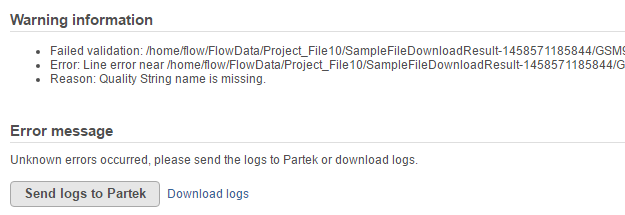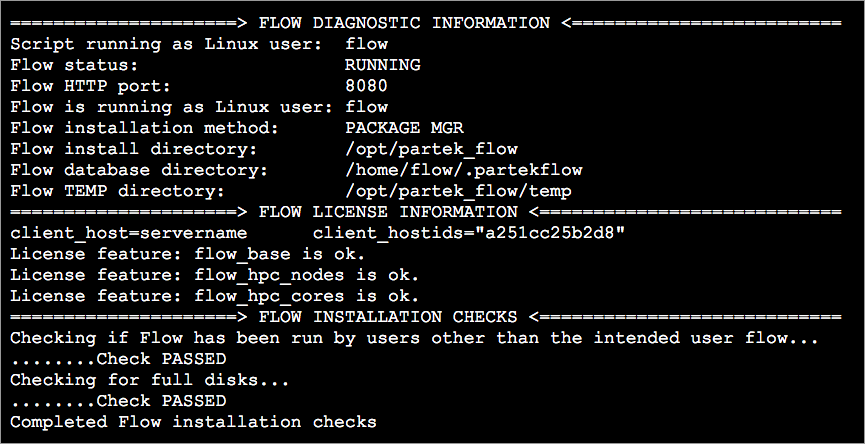Partek Flow comes with a standalone diagnostic script that reports how Partek Flow is installed and detects common installation problems.
flowstatus.sh script
This script can be run independently of Partek Flow as installation issues or crashes can prevent Partek Flow from starting. This utility gathers Partek Flow log files and server information which, upon customer approval, will be sent to Partek so our support team has all requisite information to address the issue. Some examples of when this script should be run include:
- Support team needs additional information and will request this script be run
- Partek Flow crashes or is otherwise inaccessible
- Partek Flow is unable to see input or output directories or projects are suddenly missing
- Unexpected behavior after a Partek Flow or system update
- Tasks fail to run due to missing files or directory permission issues
When a task fails, the first course of action is to enter its task's details page (Figure 1), then click on the button labeled Send logs to Partek. This creates a support ticket and you will be contacted. In some cases the task failure logs sent when clicking on this button do not contain adequate information. In this case, Partek Technical Support team will request that you run this script. Whenever possible, please run this script as the root user to ensure that system log information is collected.
If you are unable to install Partek Flow, this script will not be available. Please contact Partek Technical Support if you cannot install Partek Flow.
Running flowstatus.sh via the command line
Locate the Partek Flow installation directory. This is defined as the FLOWhome variable in the file /etc/partekflow.conf.
$ grep FLOWhome /etc/partekflow.conf
For this example, we assume the Partek Flow install directory is /opt/partek_flow. If it is not, replace it with the directory found in step 1.- Run the script
$ bash /opt/partek_flow/flowstatus.sh
After the script is run, a report will appear on the screen, then you will be asked if you wish to upload this report to Partek. If this report is uploaded, you will be contacted by support team who will assist with your issue.
Running flowstatus.sh via the command line (alternative method)
If you get an error saying, "No such file or directory" or you are unable to find the flowstatus.sh script on your system, then run the following:
Linux
$ wget https://customer.partek.com/flowstatus.sh
$ bash flowstatus.sh
MacOS
$ curl -O https://customer.partek.com/flowstatus.sh
$ bash flowstatus.sh
Interpreting flowstatus.sh reports
When running the flowstatus.sh script, you will see a report similar to Figure 2.
The relevant details of the report are:
Script running as Linux user: The user account the flowstatus.sh script was run under
Flow status: Is the Partek Flow server running or not?
Flow HTTP port: To use Partek Flow, most users will access the URL http://localhost:8080. The number associated with this URL is the HTTP port which defaults to 8080. Sometimes this port will be changed to another value. For example, if the port was changed to 8081, you will need to access Partek Flow by visiting the URL http://localhost:8081.
Flow is running as Linux user: The user account under which the Partek Flow server runs. This defaults to 'flow', however, this could have been changed to ameliorate permission issues by running Partek Flow under the same user that is the primary user of this server (i.e. the user that logs into and uses the desktop on this server).
Flow installation method: For all default installs, Partek Flow is installed with the package manager. If this is not your installation method, you are advised to contact Partek support in order to maintain your Partek Flow installation or assist with installation issues. The conversion steps are described in the next section.
Flow install directory: By default, this should be /opt/partek_flow. If this is not the case, the upgrade process for Partek Flow becomes more involved.
Flow database directory: This is a relatively small directory that stores all Partek Flow configuration and information about analysis and projects generated by Partek Flow. It is crucial that this directory be backed up regularly. If it is removed or corrupted, ALL projects in Partek Flow disappear. The actual raw input and output files for all projects are not lost, however.
After displaying Partek Flow configuration information, several installation checks are performed. This covers common issues that can break a Partek Flow installation such as full disks or running Partek Flow under the wrong user account.
Sending the error report to Partek
At the end of the report, you will be given an option to send the error to Partek (Figure 3).
In some cases, the https connections may be blocked from the server and sending the error would fail. The logs can be zipped and sent manually using the method described here.
Additional Assistance
If you need additional assistance, please visit our support page to submit a help ticket or find phone numbers for regional support.


| Your Rating: |
    
|
Results: |
    
|
34 | rates |



1 Comment
Melissa del Rosario
author: mdelrosario